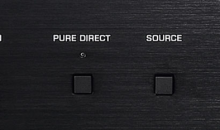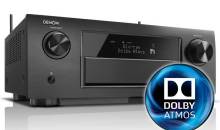Onkyo TX-NR Receivers Features Step-Chart
While it may be impossible to buy the very best A/V receiver for any and all scenarios, you can run a comparison on Audiogurus.com to narrow down your choices and arrive at the best selection for your needs. But what if you are already pretty sold on which brand you want to take home (like Onkyo, for example)? Then it’s just a matter of picking out the features that are most important to your particular needs. Audiogurus developed a series of manufacturer-based Step Charts in order to help you peel back the confusing layers of features and capabilities that make one Onkyo TX-NR series model differ from another. Using our AV receiver Step Charts (plus our handy notes on what to focus on between models), you can really narrow down the decision-making process and drill down to exactly which receiver is going to meet your specific needs.
Onkyo is possibly the “widest” manufacturer of AV receivers right now next to Yamaha. There are roughly nine models in the current line-up of TX-NR receivers. Each model varies in either power, features, capabilities, or some combination of all three. Our charts will (hopefully) help you decide which features you need—and which you can do without.
First, here is the Step Chart for the Onkyo’s TX-NR Series AV receivers:

If you’re looking for an Onkyo receiver, it’s good to know that you have a ridiculous amount of options and power choices.
And here are some of our notes regarding the most important things to look for as you consider upgrading from one model to another:
Breakpoint 1: Get Out of the Gate
Onkyo’s entry-level TX-SR313 is just that—entry-level. It won’t give you 4K support (not even pass-through), won’t pass HDMI in Standby mode, and won’t give you any sort of streaming media support. In fact, this is the only current Onkyo receiver that doesn’t allow you to use the company’s iOS/Android Remote App to control it (there’s not network connection for it to communicate with the remote or the Internet).
Breakpoint 2: 7.2, Marvell Qdeo, Wi-Fi, Bluetooth and Phono
When you step up to the TX-NR626, it’s like the floodgates of features open up. There’s the excellent Marvell Qdeo video processing and 7.2 channels (7 amps and two subwoofer outputs). But you also get Bluetooth audio streaming, which means you can send just about any signal from your smart phone to your AV receiver and listen to whatever source you want. Of course the NR626 already includes Pandora, Spotify, Sirius XM and Rhapsody—so you’re already sitting pretty on streaming services. Plus, built-in Wi_fi connectivity means that you don’t need to run a cable in order to connect to these streaming services. The TX-NR626 is an amazing receiver and pretty much the “must-have” product in the entire Onkyo line-up. It’s also the first model to include a Phono input (and all models above it include Phono as well).
Breakpoint 3: Zone 3, THX Select2 Plus, More Inputs
There is only a minor step up to the TX-NR727. You get a bit more power (110 watts from the 95 watts per channel of the TX-NR626) but you also get a couple more HDMI inputs, a Zone 3 preamp output and THX Select2 Plus certification.
Breakpoint 4: Multi-channel Inputs/Outputs, RS-232C and a Trigger Out
The TX-NR828 is Onkyo’s first custom installer-friendly product, with RS-232C and a trigger output. There are minor additions as well, such additional digital audio inputs and another component video input (the TX-SR313 and TX-NR525 also have two component inputs, but they only pass video and do not get upconverted to HDMI).
Breakpoint 5: HDMI Zone 2, 9 Channels
While the Onkyo TX-NR626 has two HDMI outputs, the TX-NR929 is the first model that lets you use one to send a discrete source to Zone 2. This is also the first 9-channel receiver and it even includes 11.2 preamplifier inputs for those who are very ambitious with their sources.
Breakpoint 6: HQV Vida, Subwoofer Outputs, Serious Power
The next three Onkyo receivers take a decidedly steep step upwards in terms of build quality and power output. From the TX-NR929 to the TX-NR1010 there is a 10 pound weight gain. The features don’t change all that much, so what you’re looking at here is a shift to a much more capable platform and power supply. Even the depth of the receiver increases by a full inch. Between the TX-NR1010, 3010 and 5010 you increase in power, preamp inputs and not much else. Onkyo gives you more power for your money—it’s about as simple as that.
Onkyo’s receivers are really top notch in both the features and quality department. They don’t insert lead bricks into their receivers, so the weight gains you see across the board are legitimately tied to larger power supplies and better quality components and construction. Form the TX-NR727 onward, you also see THX certification. THX Select2 Plus is available through the TX-NR929, and THX Ultra2 Plus is present on the TX-NR1010, TX-NR3010 and TX-NR5010 receivers. All of Onkyo’s network-ready receivers can be controlled via their iOS/Android remote control app.







What does ‘E’ stands for? like what is the difference between tx-nr686 and tx-nr686E ??
We’ve never heard of the E model.
on TX-SR series like TX-SR600 and SR600E ( E stand for Euro version) i have not seen any E on NR series